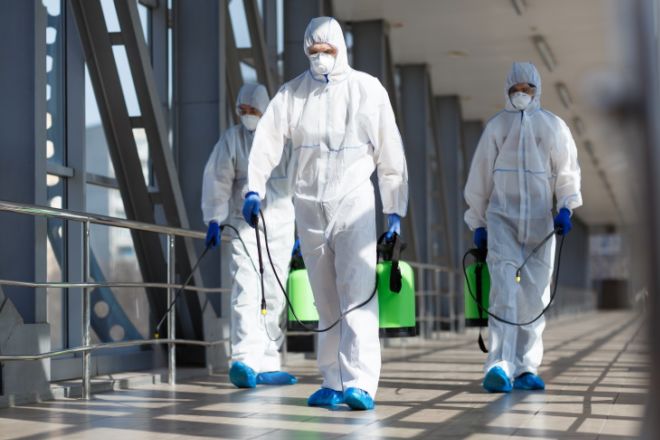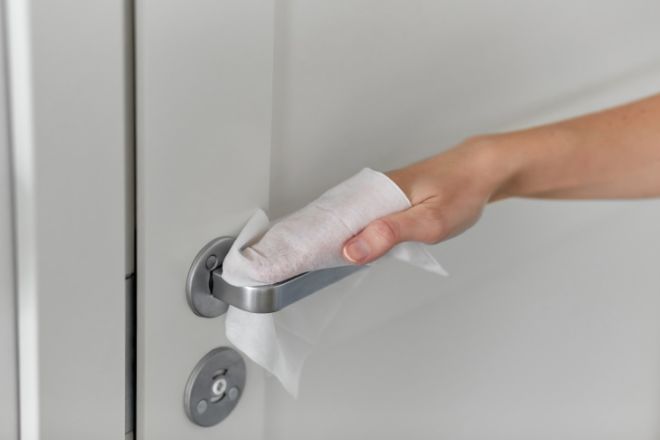COVID-19 has single-handedly turned most of us into germaphobes. Both on a personal and country-level, cleaning and disinfection have skyrocketed during the past few weeks. We are wearing masks to protect us from the droplets of the Coronavirus in the air, we keep washing our hands and wear gloves to avoid contamination from the objects we touch, and we are constantly cleaning the surfaces in our homes. Whole teams of professionals wearing protective suits and masks are sent to spray down areas affected by the virus, and the disinfection of public transportation and other community spaces has been amped up worldwide.
In part, this is because other than social distancing, cleaning and personal hygiene are the only weapons we can use to fight the Coronavirus, but it’s also because, until recently, we had no idea how long the dangerous virus could survive on different surfaces. The first studies testing how long Sars-CoV-2 can remain active in the air and on surfaces have started emerging, and they teach us that the incessant measures we have been taking were not in vain.
How Long Does the Coronavirus Survive on Surfaces?

As you likely know, the novel Coronavirus is not unlike other respiratory viruses, such as the flu, and it spreads through microscopic droplets from the infected person when they cough or sneeze, with just one cough being capable of producing thousands of such droplets. Some sources also suggest that the virus can spread through fecal matter.
If not prevented, these infected bodily fluids may ultimately travel to another host for the virus in a variety of ways. While the smallest particles of the virus can remain in the air, most settle on other people, their clothes and surrounding surfaces. And while it isn’t clear how likely a person becomes infected from the air and surfaces they touch, major health organizations like the CDC and the WHO do urge us to maintain thorough hygiene and cleaning habits during this time.
Until recently, we didn’t know how much time Sars-CoV-2 can remain active on various surfaces, and we had to suppose that it is like other coronaviruses like SARS or MERS in that respect. Fortunately, scientists are learning more about the novel Coronavirus every day, and research from the US National Institute of Health shows exactly how long the virus is capable of surviving outside of the human body.

The study suggests that Sars-CoV-2 remains active on different surfaces for the following times:
- Microscopic particles can survive for up to 3 hours in the air. This is why it is not advised to use a feather duster during cleaning or shake up any clothes and textiles, as the virus may be picked back up in the air and inhaled. Clean your home with a damp cloth instead.
- The virus only survives for 24 hours on cardboard, so there’s little to no risk of being exposed to the virus through your mail or through grocery shopping
- It can take 2-3 days for the virus to dissolve on plastic and stainless-steel surfaces. With that in mind, make sure to clean the most used surfaces in your home as much as you can and wash your hands after being exposed to plastic and metal objects in public spaces.
- Copper surfaces kill the virus in just 4 hours, as will wood, so objects made of these materials are safer than plastic and other metals.
- It remains unclear how long the virus survives on porous surfaces like clothing and textiles, but it has been suggested that the virus may be absorbed by the fibers and die more quickly than on hard surfaces.
The bottom line is, the virus can remain active on things like ATM machines and elevator buttons, door handles, phones, keys, countertops and laminated table-tops for 1 to 3 days, depending on the material, so cleaning and avoiding widely-used objects like the ones we mentioned before in public spaces is key. It is also important to learn how to clean specific objects and utilize this new information we’ve just learned.
Which Measure Can and Cannot Kill the Coronavirus?

Luckily, the molecular structure of viruses like the Coronavirus are very fragile, and their lipid coating can be easily dissolved through the use of chemicals. The chemicals that are known to annihilate the virus are:
- Alcohol in the concentration of at least 62-71%, including Listerine or other mouthwash (it’s around 65% alcohol). You can use alcohol to both disinfect surfaces, such as your smartphone, and to clean your hands via a hand sanitizer.
- 0.5% hydrogen peroxide can be used to clean hard surfaces, but it may stain.
- Bleach containing 0.1% sodium hypochlorite is effective at disinfecting clothing and your home.
- Soap is the best way to remove the virus from your skin, especially if you wash your hands for 20 seconds or more and in hot water. You need it to become foam, which is the most efficient way to take off the virus, that is why you need at least 20 seconds – to turn it to lather.
The cleaners that are ineffective at destroying the novel Coronavirus are: vinegar and alcoholic beverages like spirits or vodka (these are typically no more than 40% alcohol), as none of these are capable of permeating and dissolving the fat coating of the virus. The same goes to hand sanitizers with no or less alcohol than 65%. Antibiotics and antibacterial products will not be useful. They only kill bacteria, not viruses.
Like all viruses, Sars-CoV-2 is also very sensitive to temperature, light, and humidity, and it is typically destroyed in dry and hot climates (above 20 degrees Celsius or 68 degrees Fahrenheit). Exposure to UV light or sunlight also kills the virus, but exposure to UV light is dangerous for the skin, so this method should be reserved for the disinfection of objects.With all that information in mind, it remains crucial that you should continue cleaning and disinfecting your home thoroughly through the different methods we just named. It’s also important to wash your hands and avoid touching your face with dirty hands. Interestingly, doctors from the John Hopkins Hospital also point out that trimming your nails short and moisturizing your hands is important, too. The most dirt hides under our fingernails, as well as most of the virus. With very short fingernails, you’ll have a lot fewer germs underneath your fingernails, and a protective coating of the moisturizer will not allow for the virus to penetrate your skin.
Stay safe!


